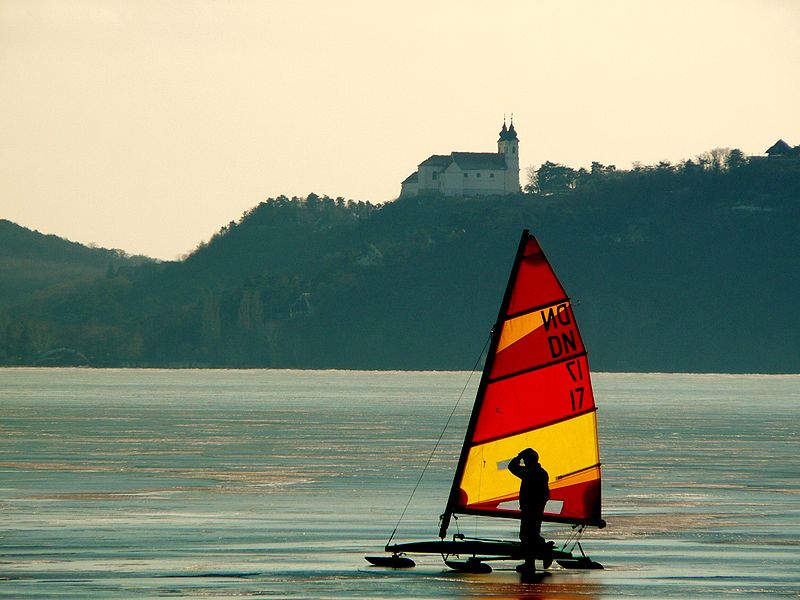But as the wind blows snow in your face when you shovel your driveway, don't lament. The active time you enjoyed from spring to autumn doesn't have to be over. Yes, there's downhill and cross-country skiing, but you can also tap into water sports. Or at least, water in its solid state of matter, sometimes called “hard water.”
The structure of iceboats varies in shape and material, but the most common shell is pointed at the bow, thin, and elongated, like a rowing scull.
You might be familiar with Estonia's tradition of jääpurjetamine (ice sailing), in locales like Haapsalu and Pärnu. According to a stunning video from Kopterid EE, sailboats on ice can travel at 80 kilometres per hour (roughly 43 knots). The initial start up of these vessels is similar to bobsleds, in the way that they are given a solid running start. This is done to push the sail into the best envelope of wind. The structure of iceboats varies in shape and material, but the most common shell is pointed at the bow, thin, and elongated, like a rowing scull. Several small, sharp-edged runners, shaped like ice skates, provide just enough surface area to carry the boat across without too much drag. Overall, an iceboat is just light enough to allow for seamless gliding across frozen bodies of water. After all, continued momentum is key in this sport.
Early iceboats were developed in Europe first, and have been documented in countries like The Netherlands in the early 1600s. From there, Oliver Booth developed a triangular vessel in 1790 in upstate New York. As you might expect, the iceboat had practical applications, in terms of carrying goods and passengers. The popularity of iceboating as a means of sport and transportation reached Hamilton Bay, Ontario early on.
According to the UK Windsurfing Association, Hoyle Schweitzer brought consumer windsurf rigs to the market in 1968, and this revolutionized summer sail-sporting. The phenomenon of windsurfing naturally caught on to its winter equivalent. As it then did with kite surfing.
The primary benefit of kite surfing is that it streamlines the amount of gear required, and therefore, the cost. As a point of comparison, a standard racing sailboat like the popular J-22, fit for a crew of three to four people, can amount to almost 27,000 Canadian dollars. On top of this, the regular maintenance, insurance, and storage of a sailboat can hover around 5,702 CAD per year (based on information collected by Intuit's Mint Life publication).
Then, iceboats, like ones advertized by clubs in the United States, can sell for around $4,000 US dollars. Depending on the engineering of the rigs and the shell design, however, iceboats can clock in at even faster speeds than listed above. But what if there was an even more affordable option? Something that beginners to sail sports could get into, with a solid one-time investment and easy-to-grasp skills from the outset?
Kitewings are especially convenient because there are no lines between you and the kite. The wing is held directly in your hands and can be positioned, requiring less sensitivity.
The sound of scraping on ice resounds from far away, across northern Europe. Kites, including those operated at height with lines and those held in your hands, have taken off as an alternative to iceboats and windsurf rigs. The gear is minimal. It's feasible to fit into a travel-sized bag. Kites are convenient to carry around the world— not least, to Estonia. Kitewings are especially convenient because there are no lines between you and the kite. The wing is held directly in your hands and can be positioned, requiring less sensitivity. Kites and Kitewings (available through a company of the same name— see kitewing.com) are an innovative means to access the thrills of flying across the ice, and also the water in the warmer months.
Formed in Worthsee, Germany in 1987, the World Ice and Snow Sailing Association (WISSA) saw its first handheld sail at the 1991 Championship in Estonia. A finger to the pulse of Estonian sports indicates a strong contingent of kites and Kitewings on ice, which is growing by the day. Together with a pair of skis, you too can be part of this new wave in sports. A brand new Kitewing 5.5 Dacron, used for ice kiting, totals at 899 US dollars. It could even be used with a skateboard or snowboard.
Compared to many other extreme sports, this is an excitingly accessible opportunity, especially for young people on a budget. And why not in Canada, too? It takes some preparation and caution to make sure you are safe and don't go onto ice that is too thin. However, Lake Simcoe is already a popular iceboat spot, so the future is open for many to take part in ice kiting and the use of the Kitewing.




